It is one of Fort Worth’s most enduring—and maddening—cold cases, a riddle wrapped in a mystery inside an Oldsmobile Cutlass Supreme.
Over its forty-eight-year history the case has taunted investigators with a suspicious letter and a phantom phone call received, swamps dredged, bones, teeth, and underwear analyzed, rewards offered and posters distributed, cars raised from lakes, and psychics and one Hawaiian dowser consulted.
After forty-eight years the case comes down to this: few clues, fewer suspects, and no closure.
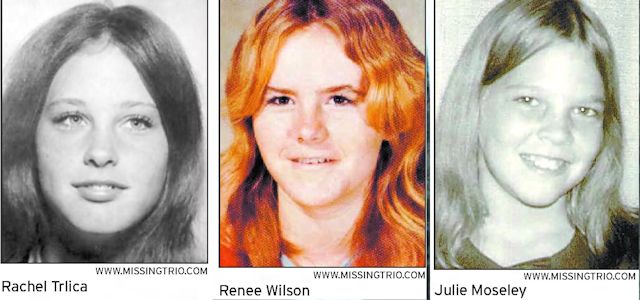 About noon on December 23, 1974 Rachel Trlica, seventeen, Renee Wilson, fourteen, and Julie Moseley, nine, set out to do some last-minute Christmas shopping at Seminary South mall (La Gran Plaza today). Rachel parked her Oldsmobile on an east lot near the Sears store.
About noon on December 23, 1974 Rachel Trlica, seventeen, Renee Wilson, fourteen, and Julie Moseley, nine, set out to do some last-minute Christmas shopping at Seminary South mall (La Gran Plaza today). Rachel parked her Oldsmobile on an east lot near the Sears store.
Renee was determined to be back home by 4 p.m. to attend a Christmas party that night. Julie’s mother had told her to be home by 6 p.m.
When those two times passed, parents of the girls grew concerned and went to the mall to investigate.
They found the car. It was locked. Purchases that the girls had made that day were on the rear floorboard.
Rachel’s mother went into the mall, into every store, and asked each manager to make an announcement to see if the girls were there.
The parents notified Fort Worth police, but police never act as quickly as worried parents would like.
So, that night the fathers of the three girls, armed with a shotgun, staked out the abandoned Oldsmobile, waiting for any ne’er-do-well who might return.
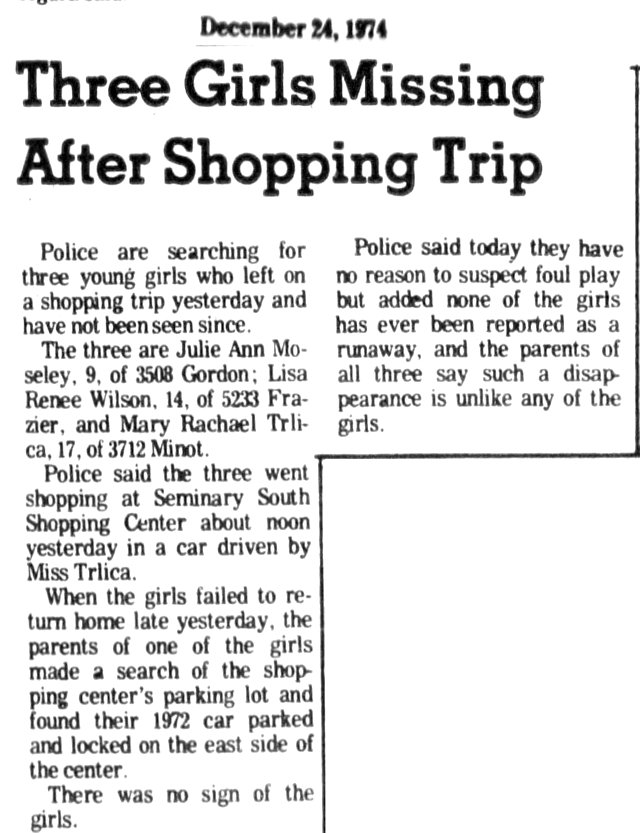 Although the parents feared foul play, police theorized that the girls had run away from home (although none of the girls had done so before).
Although the parents feared foul play, police theorized that the girls had run away from home (although none of the girls had done so before).
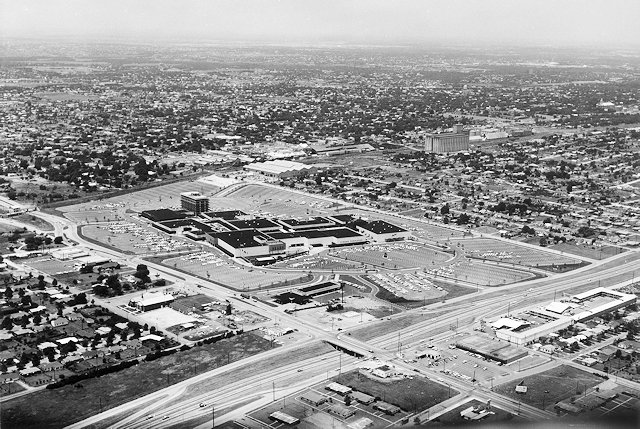
Seminary South about 1962. (Photo from Jack White Photograph Collection, University of Texas at Arlington Libraries.)
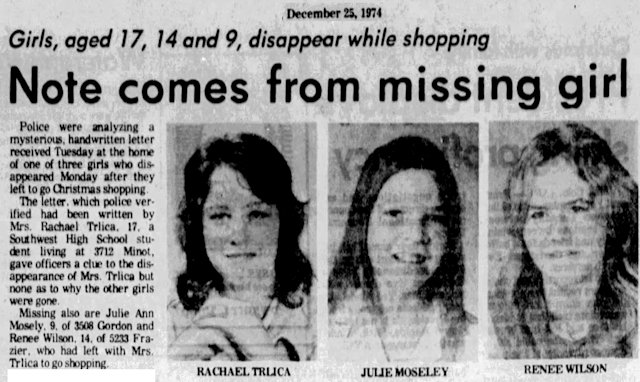 That theory gained support the next morning—December 24—when a letter arrived at the home of Rachel and her husband of six months, Tommy Trlica, twenty-two.
That theory gained support the next morning—December 24—when a letter arrived at the home of Rachel and her husband of six months, Tommy Trlica, twenty-two.
In the upper-left corner of the letter’s envelope the name “Rachel” was scrawled in pencil. But the envelope was addressed rather formally: to “Thomas A. Trlica.” Rachel called her husband “Tommy.”
The stamp on the envelope had been canceled that morning. The cancellation did not include a city, and the ZIP code of the cancellation was blurred. Investigators interpreted the five-digit number to indicate that the letter had been mailed either from Throckmorton, Texas, from Eliasville, which is near Throckmorton, or from Weatherford.
Inside the envelope was a sheet of paper with this message written in ballpoint ink in a childish scrawl:
“I know I’m going to catch it, but we just had to get away. We’re going to Houston. See you in about a week. The car is in Sear’s upper lot. Love Rachel.”
The original l of Rachel’s signature on the letter had been a short loop that looked more like an e. The writer had gone back over it, making it a taller loop.
Nonetheless, one investigator thought the handwriting matched a known sample of Rachel’s. But the parents of the three girls and Rachel’s husband were skeptical that Rachel had written the letter.
Over the years various investigators would deem the letter to be genuine, a prank, and inconclusive. Three times FBI analysis of the handwriting was inconclusive.
But consider this: The envelope’s stamp was canceled on the morning of December 24—and thus the letter was written and mailed before that time. The first news account of the girls’ disappearance did not appear until that evening’s Star-Telegram. That account said that the girls’ car was “parked and locked on the east side of the center.” And yet the writer of the letter had known that “The car is in Sear’s upper lot.”
After examination of Rachel’s car yielded no clues, police investigators turned to the mall. Oh, certainly employees and shoppers in the mall had seen the girls. A few remembered Renee’s T-shirt with “Sweet Honesty” printed on the front.
But police learned nothing useful.
In the absence of solid leads and forensic clues, theories abounded: The girls had left the mall of their own volition, perhaps with someone they knew; the girls had been taken from the mall against their will; or perhaps some combination of the two: The girls had left voluntarily, but then something sinister happened.
 On December 27 a reward fund for information “leading to the recovery” of the girls was established.
On December 27 a reward fund for information “leading to the recovery” of the girls was established.
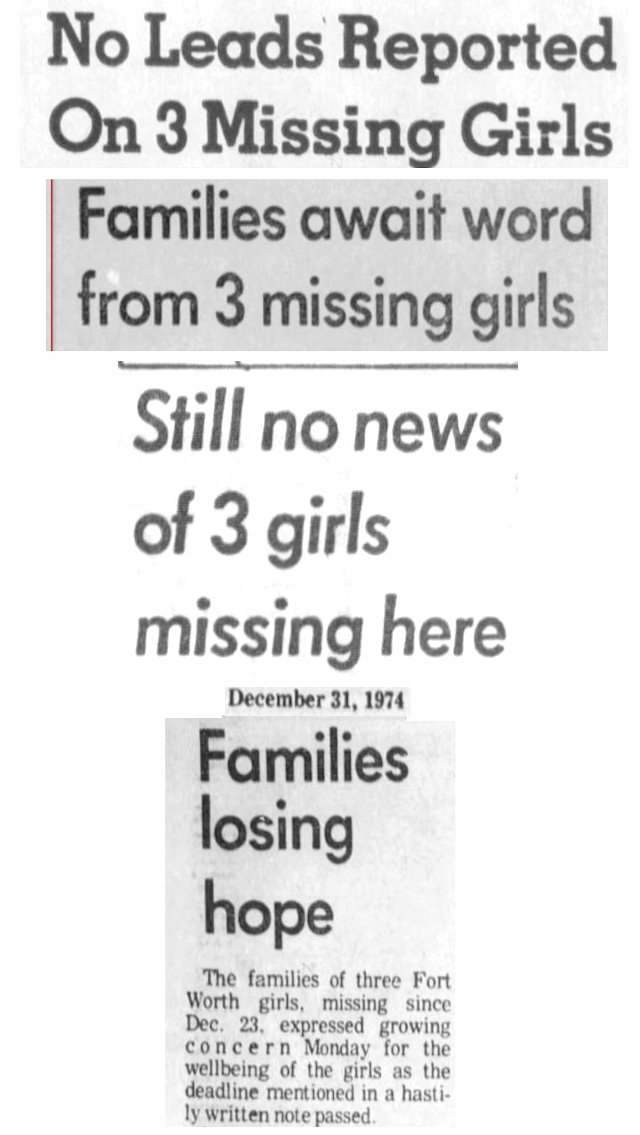 But as the year ended the Star-Telegram could report only “no news” news.
But as the year ended the Star-Telegram could report only “no news” news.
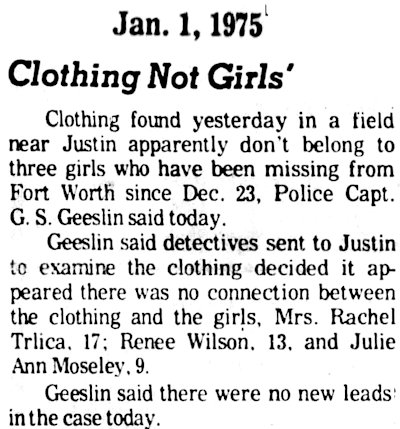 The new year started with the first of many false leads as undergarments found near Justin were determined to be unrelated to the case.
The new year started with the first of many false leads as undergarments found near Justin were determined to be unrelated to the case.
Within a week of the disappearance of the three girls, their families were in contact with psychics.
First up was Mr. Joseph of Dallas, whom the families visited in person.
“The psychic told us things about Renee that I would not expect him to know,” Renee’s mother, Mrs. Richard E. Wilson, said. Mr. Joseph told the families that “dope is involved, there are three to five people involved, and the girls are being held against their wills.”
“He told us that Renee cannot get home,” Mrs. Wilson said, and visualized the girls around a lake with horses nearby.
Mrs. Wilson also said Mr. Joseph said Julie Moseley had been wearing red tennis shoes—a detail not reported in the media.
Mr. Joseph asked Tommy Trlica if 150 meant anything to him as a sum of money. Trlica said $150 in bonds had been in the Oldsmobile the day his wife drove it to the mall but was not in the car when police examined it.
Mr. Joseph also said he “sensed” that something was wrong with the letter reputedly written by Rachel Trlica to her husband. He said he felt that the girls had gone north toward “Grapevine, Oklahoma, or Illinois,” not south to Houston.
The three families consulted other psychics by mail, sometimes sending them an article of clothing that had been worn by the girls. About sixty percent of the psychics claimed that a “blue hippie van” was involved in the disappearance. The same percentage believed—like Mr. Joseph—that the girls had traveled north, not south as the letter had claimed.
But one psychic told the families that the girls’ bodies were in a shallow grave near a creek in Mansfield. Rachel’s mother—Mrs. R. W. Arnold—Rachel’s older sister Debra, and Mrs. Wilson walked several miles of creek bank, following a map the psychic prepared.
“At one point,” Mrs. Arnold said, “where one of the girls was supposed to have been, Debbie reached down into the water and pulled up the skull of a pig.”
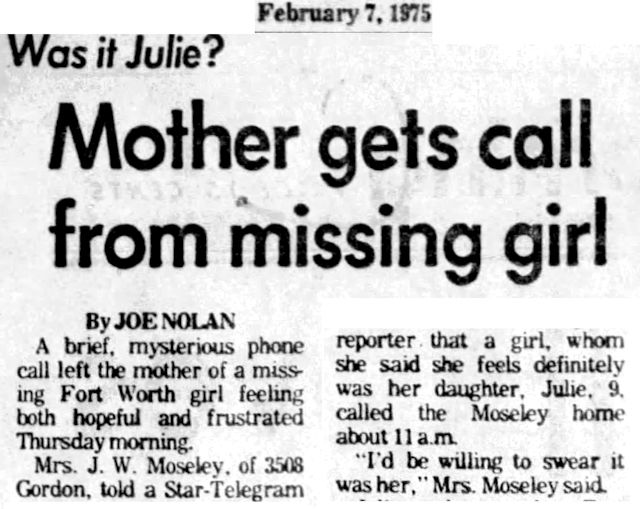 Six weeks after the three girls disappeared, about 11 p.m. on the night of February 6 Mrs. J. W. Moseley, mother of Julie, received a telephone call. The caller was a girl. Mrs. Moseley later told the Star-Telegram that she believed that the girl was her daughter.
Six weeks after the three girls disappeared, about 11 p.m. on the night of February 6 Mrs. J. W. Moseley, mother of Julie, received a telephone call. The caller was a girl. Mrs. Moseley later told the Star-Telegram that she believed that the girl was her daughter.
“I’d be willing to swear it was her,” Mrs. Moseley said.
She said that when she answered the telephone no one spoke to her at first, in spite of the fact that she said “hello” several times.
And then, as Mrs. Moseley started to hang up the receiver, she heard a low moan, and a girl said, “Mama.”
“I asked, ‘Who is this?’ and Julie said, ‘Mama’ again,” Mrs. Moseley said.
Mrs. Moseley by then was positive she was speaking with her daughter and asked the caller, “Is this Julie Moseley,” and the caller replied, “Yes.”
“Listen, if this is someone playing a joke, please stop. I can’t take anymore,” Mrs. Moseley told the caller. Mrs. Moseley said she then asked the caller where she was, and the girl said she did not know.
“Julie said ‘Mama’ once more and was just starting to say something else when the phone was hung up,” Mrs. Moseley said.
“I just kept screaming ‘Julie!’ after the phone went dead,” Mrs. Moseley said, “and then I realized, after a few minutes, that I was hearing a dial tone so I hung up.”
She said the girl wasn’t speaking normally and sounded either drugged or sick.
“I know there is the possibility someone is putting me on,” Mrs. Moseley said, “but I’m positive that was Julie on the phone. At least I now know she is alive, and that helps, but where is she?”
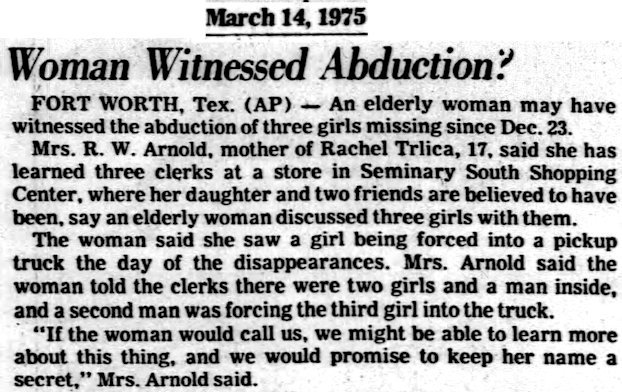 In March 1975 Rachel’s mother, Mrs. Arnold, learned that a woman had told clerks at Seminary South that she had seen a man forcing a girl into a pickup at the mall on December 23. Inside the pickup were two girls and second man.
In March 1975 Rachel’s mother, Mrs. Arnold, learned that a woman had told clerks at Seminary South that she had seen a man forcing a girl into a pickup at the mall on December 23. Inside the pickup were two girls and second man.
Nothing came of that information.
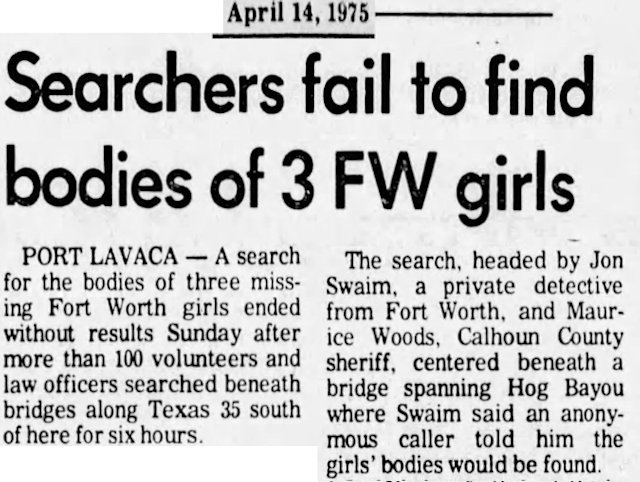 Over the decades the families of the missing girls, frustrated by the police investigation, would hire several private investigators. One of the first was Jon Swaim. In April 1975 an anonymous caller told Swaim that the bodies of the three girls were under a Texas Highway 35 bridge near Port Lavaca on the gulf coast.
Over the decades the families of the missing girls, frustrated by the police investigation, would hire several private investigators. One of the first was Jon Swaim. In April 1975 an anonymous caller told Swaim that the bodies of the three girls were under a Texas Highway 35 bridge near Port Lavaca on the gulf coast.
In February Port Lavaca police had received a similar claim about the three girls. Police had searched area bridges but found nothing.
In April Swaim and members of the girls’ families were present as one hundred people searched for six hours and found exactly what the police had found in February.
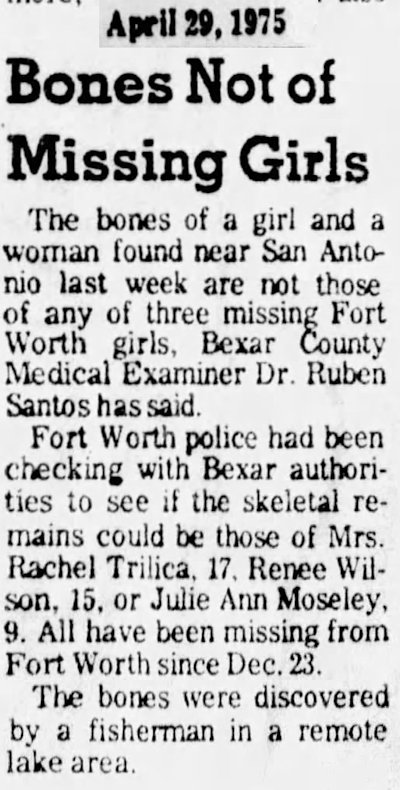 Also in April 1975 bones of a girl and a woman found near San Antonio were determined to be unrelated to the Seminary South case.
Also in April 1975 bones of a girl and a woman found near San Antonio were determined to be unrelated to the Seminary South case.
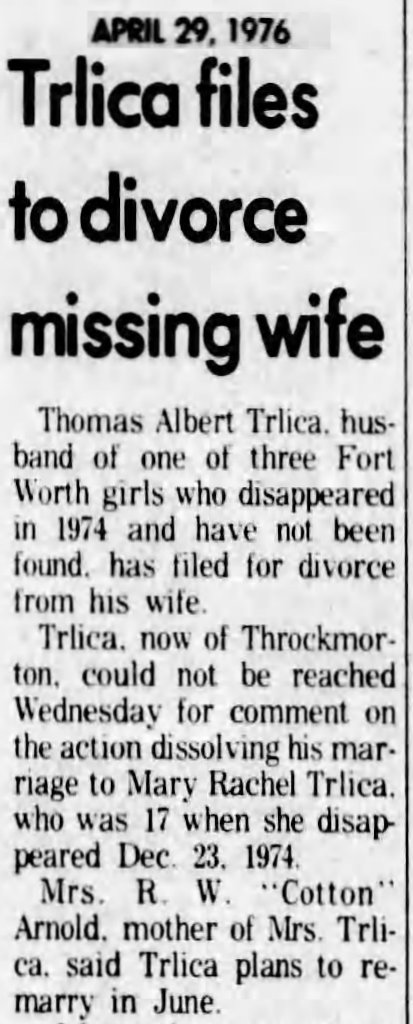 Not surprisingly, Tommy Trlica, as Rachel’s husband, was a suspect but only briefly. In 1976 he divorced his missing wife, remarried, and moved to Throckmorton. He lost contact with his former in-laws.
Not surprisingly, Tommy Trlica, as Rachel’s husband, was a suspect but only briefly. In 1976 he divorced his missing wife, remarried, and moved to Throckmorton. He lost contact with his former in-laws.
 The private investigators hired by the three families had to follow up leads both legitimate and ludicrous. One of the latter came in May 1976 when a “professional dowser” (person who uses a divining rod) in Hawaii wrote to private detective Swaim.
The private investigators hired by the three families had to follow up leads both legitimate and ludicrous. One of the latter came in May 1976 when a “professional dowser” (person who uses a divining rod) in Hawaii wrote to private detective Swaim.
Writing from Honolulu the dowser wrote that the girls had been killed and their bodies dumped, not buried, in brush near a gas well off Texas Highway 36 three miles east of the town of Rising Star.
Members of the missing girls’ families, hoping against hope after sixteen months, were present as forty lawmen and volunteers beat the bushes amid the jackrabbits and jackpumps of rural Eastland County for five hours, after which time the dowser was being referred to as a “psycho,” “nut,” and “somebody who ought to be investigated.”
 Later that summer Swaim and Tarrant County investigators were in Brazoria County after the skeletal remains of one male and two females were found in a field.
Later that summer Swaim and Tarrant County investigators were in Brazoria County after the skeletal remains of one male and two females were found in a field.
On the fourth anniversary of the girls’ disappearance in 1978 Fort Worth police investigator George Hudson admitted, “We’ve never even gotten them off the parking lot of the shopping center.”
 The year 1981 brought two disappointments to the families of the three girls.
The year 1981 brought two disappointments to the families of the three girls.
Human bones were again found in Brazoria County in a swamp. The bones were unrelated to the Seminary South case.
Since the beginning of the mystery, Fort Worth police, via news stories, had appealed to witnesses to come forward.
In 1981 a Houston man who had been in Fort Worth visiting his sister told police that on the day the girls were last seen he had been at the mall when he saw three men force three girls into a van near a supermarket in the mall. The man said that when he approached the men, one of them said the oldest girl was his wife. The man said he had made a mental note of the license plate number. But he went back to Houston and was unaware of news coverage of the missing girls until he moved to Fort Worth and heard about the case from a friend of Rachel’s mother, who said police tried to hypnotize the man to learn the license plate number but failed and could not give him “truth serum” because of a heart condition.
By Christmas 1982 the girls had been missing eight years. Renee Wilson’s mother said of her daughter: “Oh, I dream about her quite often. I know that she hasn’t changed. She’d be tall, and headstrong, spoiled, you know.”
On that first Christmas in 1974 after Renee disappeared, Mrs. Wilson had kept Renee’s gifts under the tree. As the years passed, Mrs. Wilson could not part with the gifts and stored them in her attic. They were still there in 1982.
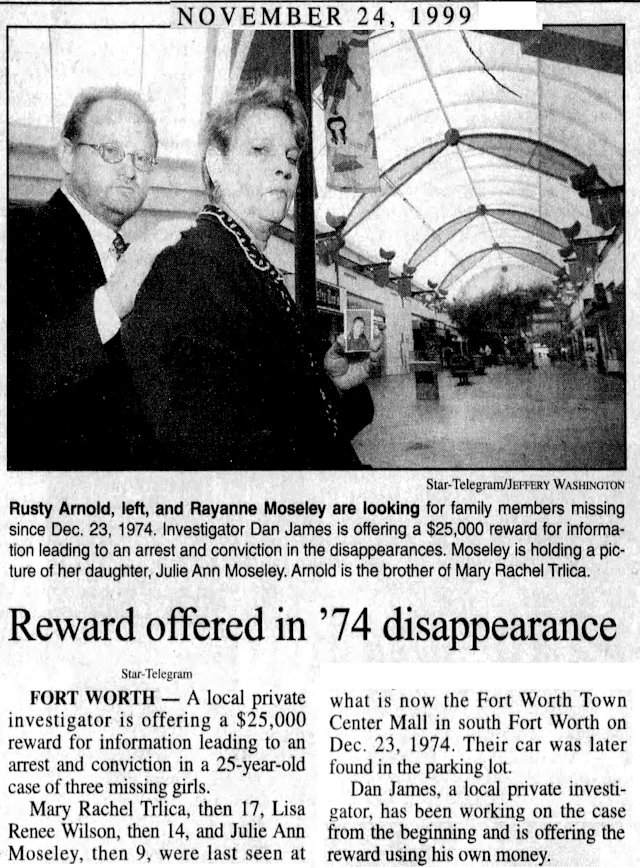 Perhaps the case’s most dogged searcher—more dogged than the police or the private investigators—over the years has been Rachel Trlica’s brother Rusty Arnold, who was eleven when his sister disappeared.
Perhaps the case’s most dogged searcher—more dogged than the police or the private investigators—over the years has been Rachel Trlica’s brother Rusty Arnold, who was eleven when his sister disappeared.
Arnold created a website and a Facebook group to keep the case in the public eye.
About 1996 Arnold met private investigator Dan James, who had followed the case since the beginning.
In December 1999 James personally offered a $25,000 reward for information leading to the arrest and conviction of anyone responsible for the disappearance of the girls.
James said several “credible witnesses” had told him they had seen Rachel since her disappearance.
“One was in 1998 around Christmas,” he said in 1999.
James said he had received death threats from anonymous callers warning him away from the case.
In 2000 the Star-Telegram wrote that Arnold and James believed that Rachel visited Fort Worth during the Christmas season each year. James said he believed that Rachel was the only one of the three girls still alive.
He was evasive about details of his theory of what happened to the girls.
“I believe that [a] person facilitates and maintains an effort to keep Rachel Arnold [Trlica] away from Fort Worth. I believe that Renee Wilson is not alive. . . . I believe that something dreadfully wrong, and probably a fatality, occurred involving Julie Ann Moseley,” he said.
By 2000 Rusty Arnold’s theory was that the two older girls—Rachel and Renee—had enough family problems in 1974 that they indeed might have run away from home.
Arnold’s mother—who by 2000 had remarried and was Mrs. Fran Langston—disagreed with her son. She said Rachel would not have left her terminally ill father and also had been looking forward to her first Christmas with her stepson.
“I think the girls were taken. They didn’t leave of their own free will.”
Rusty Arnold in 2000 said his sister Rachel and Renee might still be alive. But he, like James, feared that Julie Moseley had met with foul play.
The mystery strained family ties, especially between Rusty Arnold and his older sister Debra, who briefly had been engaged to Tommy Trlica before Tommy married Debra’s sister Rachel.
In 2000 Rusty Arnold said that “someone close to one of the girls had something to do with the disappearance.”
Debra was less obtuse. She told the Star-Telegram in 2000:
“I know he [Rusty] blames me. I know he thinks I had something to do with it. . . . Rusty thinks this letter that Tommy got the next day—he thinks I wrote it. . . . I didn’t write this letter. I don’t know who did. I don’t know what happened to my sister. Maybe white slavery. That’s the only thing that makes sense to me. I have nothing to hide.”
Their mother blamed private detective James for “poisoning Rusty’s mind.”
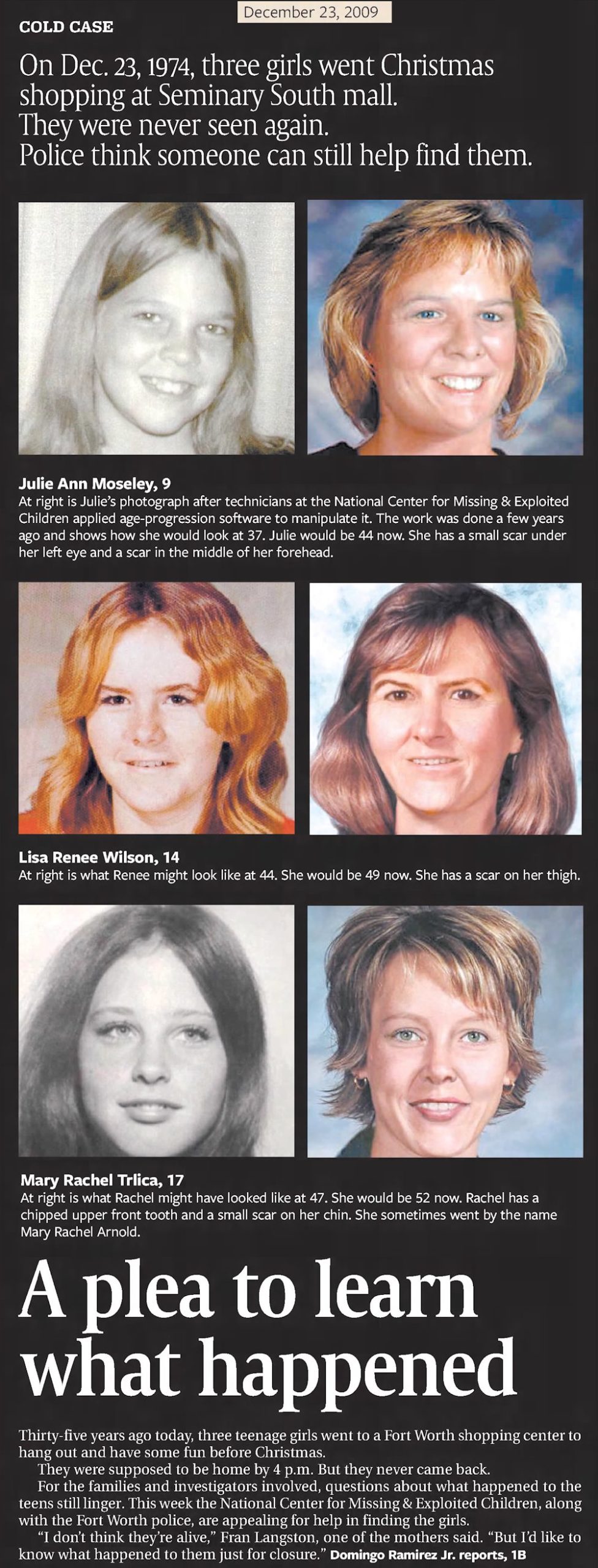 In 2009 the Star-Telegram printed these photos of the three girls. About 2004 the National Center for Missing & Exploited Children had used software to show how the girls might appear in 2004.
In 2009 the Star-Telegram printed these photos of the three girls. About 2004 the National Center for Missing & Exploited Children had used software to show how the girls might appear in 2004.
 Over the last forty-eight years the mystery has been a part of many a Fort Worth Christmas as the Star-Telegram has printed a story on the anniversary of the girls’ disappearance, a sad counterpoint to seasonal stories about grateful recipients of Goodfellow Fund aid and the lighting of the city’s Christmas tree downtown and the dismal odds of a white Christmas.
Over the last forty-eight years the mystery has been a part of many a Fort Worth Christmas as the Star-Telegram has printed a story on the anniversary of the girls’ disappearance, a sad counterpoint to seasonal stories about grateful recipients of Goodfellow Fund aid and the lighting of the city’s Christmas tree downtown and the dismal odds of a white Christmas.
The case has never produced anyone whom police would call a suspect, but in 2018 Rusty Arnold said he was investigating “a person of interest.” And although he would not name that person, he said he had a theory: The person of interest lived within five miles of Benbrook Lake and had disposed of a car soon after the three girls vanished in 1974.
So, Arnold began to wonder if that car had been disposed of in Benbrook Lake. A marine salvage company used sonar to locate three cars submerged in the lake.
In September 2018 Arnold, his mother, and more than one hundred friends and members of the missing girls’ families gathered at the lake as the marine salvage dive crew braved treacherous “black water” to depths of forty feet to raise the first car—a 1960 Corvair—from the lake.
“The car did not have any evidence linking it to my sister or the other girls,” Arnold later said.
But his mother said, “I wouldn’t have missed this for the world.”
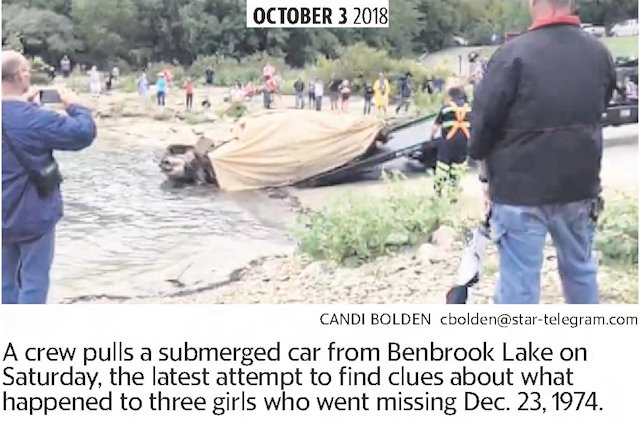 The next month Rusty Arnold and his mother again watched as the dive team assembled at the lake to raise the second submerged car.
The next month Rusty Arnold and his mother again watched as the dive team assembled at the lake to raise the second submerged car.
“I’m hoping they open that trunk and find remains. All these years, we’ve been waiting,” Mrs. Langston said as she watched from a chair on shore.
The car was a Lincoln Continental. But its vehicle identification number showed that it was a 1976 model—made two years after the girls disappeared.
A year later, in 2019, the dive team attempted to raise the third car from the black water of Benbrook Lake. But the car was severely rusted, the edges of its sheet metal like razor blades. The car fell apart as it was being lifted out of forty feet of water.
“My heart was broken,” Arnold said in 2019. “Because I’ve been working for five years on these cars. We promised my mom we would get all three out. And now we can’t live up to that promise. She’s eighty-one years old now, bless her heart. I sure would like to get closure for her before she goes.”
And there the coldest of cold cases stands.
Over the years the loss of the girls, the hopes raised and then dashed, family recriminations, thousands of dollars spent, and lack of closure took their toll on the members of the girls’ families. Mrs. Langston, Rachel’s mother, wrote a poem that perhaps sums it all up:
“If only you knew what it would mean
to mend our hearts,
To say it’s been a bad dream.”






I know
Only one is deceased and that’s the only mom I ever knew Renee Wilson became Donna Fletcher then Hawkins.
Back on the DNA post, has there been any DNA testing done? Seems there’s a new approach to using Ancestry’s DNA capability to find relatives of the perpetrators, the DNA Doe Project a non-profit helps to solve cold cases. Have they been approached about this case?
Just curious, has the stamp on the letter been tested for DNA or even the glue on the letter seal. This could eliminate some people. They should still be able to extract DNA after all this time.
Thank you for your story, Mike. I really like your hometownbyhandlebar content. This December 23rd will make 48 years of living through this tragedy for the girls’ families. Fran is now the only parent left as we lost Richard Wilson last month. He, like my parents and grandparents, all passed away without this craziness coming to any sort of conclusion. My sister and I have endured way too much heartbreak since the disappearance. I’ve always felt I can safely say that my little 9 year old sister, Julie, did not run away, as well as my girlfriend Renee did not. There was no plan on doing so, I would have known, since I was supposed to go with them that day. I always regret the fact that I didn’t. The girls left my house about 10:30, 10:45 that morning but many have it as noon. Renee asked me and my other sister Janet to go along but we both declined. Julie wanted to go but Rachel and Renee didn’t really want a 9 year old kid tagging along but relented when our mother said she could,a decision my mom beat herself up over, often. It actually drove her quite mad. That and the phone calls. She got to where the ringing of the telephone would cause her to simply lose it. Our childhoods ended that very first day. I’ve thought long and hard about everything and decided that I don’t think the girls lived beyond that first day and I don’t put any stock in any of the stories about them being shoved in a car or van at Seminary South. I feel they went with someone they knew and trusted and then something happened. What or who, I have no idea. No one ever believed the letter was real and no one believes that now. The letter is just sitting in the Fort Worth Police Department’s property room. The FWPD won’t allow anyone to even view it. I believe they see this as a black eye on their department. We’ve recently asked them if someone else could try to use the letter to actually further this investigation but I don’t think we’ve had a response. It’s been said that although this is still considered an open investigation, no one is working the case and they’re focusing on other cases that they feel they can solve. A few points I’d like to correct are that the car was found at the mall by 6pm. Everyone was mad that they weren’t home before 4pm and after that, worry turned to panic. The savings bonds were later found and weren’t in the car that day. The only thing inside the car was a gift for Tommy’s son from a previous marriage, from Renee’s grandmother. In the trunk were two pairs of jeans, both Renee’s, one old pair and one new pair. Evidently, Renee changed into a new pair when they picked up Renee’s layaway at Army Navy on Berry Street. That’s where they first went after leaving my house. Renee was so looking forward to Christmas as she knew she was getting a new stereo. I got up early the 23rd and gave Renee a promise ring. Then later, the girls left on their shopping trip. I came within a heartbeat of going with them but backed out at the last second. It was a total fluke that Julie got to go. My sister was only 9, so Christmas was still magical for her. The car was returned to Tommy the day after it was found. There were virtually no surveillance cameras at the mall since it was 1974. There has been no evidence beyond the girls going to the mall after Army Navy. I never believed any of them were alive and returning to Fort Worth periodically. I was 15 when this happened and now, I’m an old man and I feel that I’m to suffer the same fate of going to my grave without ever knowing the truth. Sorry for such a rambling letter. If you ever would like to discuss this further, please feel free to contact me.
Good morning Mr. Moseley,
I have important information to share with you. May I contact you via e-mail?
Thank you in advance for the attention and kind regards.
Wishing you a happy New Year.
Mr Mosely,
If you’re still willing I have a few questions I’d love to ask :). Please let me know.
Kind Regards,
Nev Vindigni
What about the letter Rachel supposedly wrote? Cancelled stamp with information on where the vehicle could be found in the upper sears lot before they even went shopping? The letter was mailed 1 day before with important information like where it was mailed from blurred. FBI analyzed writing and was inconclusive on whether Rachel wrote it or not.
If it was someone they knew.. and Renee and Rachel had been friends for a while and families so someone they both knew well likely. BUT WHO? Why was Rachel’s mom at the mall looking for her
she didn’t live with her? No?
She lived with Tommy her husband nothing ever mentioned about Tommy during this time. He wasn’t wondering where his car or wife was?
So many unanswered questions.
Apparently Rachel was pregnant.
A security guard was seen with them why? Did they know him? Was he questioned?
A psychic saw a van. A witness who wasn’t from the area but later moved there years later saw three girls forced into a van… couldn’t remember plates. But a van noted twice.
Julie sounds like collateral damage sadly and my condolences to everyone effected she saw who the other two girls Renee and Rachel likely knew well and was a liability.
But why kill them? Which is likely what happened what would’ve been the motive bad drug deals Tommy what did Tommy do for living, bad blood with someone, sexually motivated, money problems just random violence like what’s the motive ? Rachel was still in high-school for crying out loud and married with a 2 year old step son. Nothing makes sense nothing and no concrete clues.
Was Rachel’s mom still married to her father at time of disappance? He supposedly died 4 months later? Her and Debra moved out quite early? Why? Says they were abused but Rachel’s mother mentioned nothing about this nor 9 year old brother. What troubles did they have? Julie must’ve told you?
Did Renee live with her grandmother who lived across the street from you and Hulie and why? If she did. Her parents unstable?
If no bags from shopping mall in car they didn’t make it into the shopping mall or didn’t make it back to car from shopping mall.
Was the store Rachel applied for a job at in this shopping mall? Why wouldn’t anyone know like her husband if she got harassing calls from the store owner she was young good looking can’t see her not being a target.
A big fight at bowling alley night before disappearances?
Between Tommy Rachel Debra and Debra’s boyfriend which who the heck was he? Was he sketchy did he have an alibi what did he do for a living? I bet none this would’ve happened had you gone or you may not have lived either. So many questions sorry for picking your brain if you ever see this.
My email [email protected]
Hello Mr. Moseley,
I read about your families tragedy around 5 years ago and I always think of it when the holidays approach. I will get online to see if there has been any progress made in getting answers. I came across this site and read your post from almost a year ago. I was wondering if the Fort Worth police ever assigned anyone in the last year to actively work the case?
Good morning, Mr. Terry Moseley. I am Italian and very passionate about the Fort Worth Missing Trio case. I would like to ask you some questions that I think are important to understand the case. I read that in the shopping center the girls were seen by a certain Robbie Ramsel. Did he ever report the precise time he saw the girls? Is it true, as I read on the Facebook page dedicated to the case, that the girls in the shopping center were with Vernon B.? If that’s true, did Vernon ever report when exactly he met them and what time and where he left them? Thank you.
Great job Mike!
Thanks, Keith. A tragic, enigmatic event.
How would this Sherry McReynolds be able to fill in any blanks? I read some of the articles and see some big holes in the investigations. I am no detective, but why did Jon Swaim put in his will to have all the evidence he collected be destroyed? Surely he would have wanted to give it to the next detective. Then Jon Swaim committed suicide by drug overdose? One article said he was going through a bad divorce. When I looked up his funeral information, his spouse died in 1977, some time before he died. And those witnesses who saw the three girls in the mall and saw what one was wearing? Have you been Christmas shopping on December 23rd in any year? I worked at Dillard’s for about 8 to 10 years and I assure you that it is too busy in any mall or store at that time of the season to notice or remember anyone in particular unless you know them well and have a chance to speak to them. I am curious why the dots aren’t connecting to the professionals. Sorry if I’m being intrusive. I hope they are found and the guilty parties punished.
Jon Swaim did several unethical things such as bonding people out of jail and then canceling their bond causing them to be rearrested on their jobs.
If you would like some blanks filled in ~ I’d be willing to help. How much of the investigation have you followed?
This blog post represents the extent of my research.
Please read my above comments and questions to Terry and fill in blanks if able to do so.
[email protected]